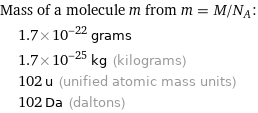Input interpretation

calcium tetrahydroaluminate | molar mass
Result

Find the molar mass, M, for calcium tetrahydroaluminate: M = sum _iN_im_i Plan: • Write the chemical formula and gather atomic masses from the periodic table. • Determine values for N_i and m_i using these items. • Finally, compute the mass. Write the chemical formula: Ca(AlH_4)_2 Use the chemical formula, Ca(AlH_4)_2, to count the number of atoms, N_i, for each element: | N_i Al (aluminum) | 2 Ca (calcium) | 1 H (hydrogen) | 8 Look up the atomic mass, m_i, in g·mol^(-1) for each element in the periodic table: | N_i | m_i/g·mol^(-1) Al (aluminum) | 2 | 26.9815385 Ca (calcium) | 1 | 40.078 H (hydrogen) | 8 | 1.008 Multiply N_i by m_i to compute the mass for each element. Then sum those values to compute the molar mass, M: Answer: | | | N_i | m_i/g·mol^(-1) | mass/g·mol^(-1) Al (aluminum) | 2 | 26.9815385 | 2 × 26.9815385 = 53.9630770 Ca (calcium) | 1 | 40.078 | 1 × 40.078 = 40.078 H (hydrogen) | 8 | 1.008 | 8 × 1.008 = 8.064 M = 53.9630770 g/mol + 40.078 g/mol + 8.064 g/mol = 102.105 g/mol
Unit conversion

0.10211 kg/mol (kilograms per mole)
Comparisons

≈ ( 0.14 ≈ 1/7 ) × molar mass of fullerene ( ≈ 721 g/mol )

≈ 0.53 × molar mass of caffeine ( ≈ 194 g/mol )

≈ 1.7 × molar mass of sodium chloride ( ≈ 58 g/mol )
Corresponding quantities

Mass of a molecule m from m = M/N_A: | 1.7×10^-22 grams | 1.7×10^-25 kg (kilograms) | 102 u (unified atomic mass units) | 102 Da (daltons)

Relative molecular mass M_r from M_r = M_u/M: | 102